- Reaction score
- 23,638
- Points
- 1,090
I could see integration challenges, if the selected model doesn't use US systems - significant NRE costs to bring combat systems and comms into the fleet..

I would be incredibly surprised if Canada goes within an entire zipcode of the Spanish and their submarine program, I understand it has been very messy. The program was delayed multiple times, the design itself had severe issues which required major redesigning, problems with their AIP variant and they ended up lengthening the submarines to the point where it couldn't fit in their related infrastructure. Canada is going to be facing an uphill battle with this procurement, we cannot afford to take such a risk for what seems like a poor return.Given the current information that I've seen/heard the new defence policy has submarines in it.
They will be MOTS. There are 6 submarine building programs that are underway with allies right now. Only three of them have production lines in operation. Korea, Japan, Spain. I would suggest looking at those programs to see what's on offer. I expect the RCN will have new submarines before we have the CSC in the water.
For the arctic, we only need submarines at the choke points on entry to and exit of the NWP during relatively ice free times. Nuke boats cannot transit the NWP in winter as the ice often goes all the way to the bottom (scraping it). That's hyper dangerous. Nuke boats go deep water arctic ocean for that reason. We don't need to be there.
While I certainly won't complain if we get new AIP subs (hopefully in sufficient quantity...I'd hope/dream for at least 8) and what you say is true as far as defensive roles for a Canadian sub, what nuclear subs give you is the submerged endurance to offer a potential offensive capability as well.Given the current information that I've seen/heard the new defence policy has submarines in it.
They will be MOTS. There are 6 submarine building programs that are underway with allies right now. Only three of them have production lines in operation. Korea, Japan, Spain. I would suggest looking at those programs to see what's on offer. I expect the RCN will have new submarines before we have the CSC in the water.
For the arctic, we only need submarines at the choke points on entry to and exit of the NWP during relatively ice free times. Nuke boats cannot transit the NWP in winter as the ice often goes all the way to the bottom (scraping it). That's hyper dangerous. Nuke boats go deep water arctic ocean for that reason. We don't need to be there.
Submarines are just one element of the entire force, we cannot afford (financially or politically) nuclear submarines which allow us to better deal with the threats you describe but having conventional submarines interlinked with MPA's and frigates is a big boost to capability. Distant war theatre deployments would be done from allied nations and bases abroad, it's a capability that I am sure our allies in Europe and Asia will appreciate if we can field submarines of a suitable size and in enough number. HMCS Chicoutimi being deployed overseas to spy on the North Koreans comes to mind as of the last few years.A conventional sub can plug some transit gaps and deter enemy subs from our near maritime approaches but when you look at the range of sub-launched cruise missiles the area you need to try and cover with a handful of slow moving boats is enormous. Even teamed with MPAs and other sensors you lack the ability to reposition quickly to face a detected threat. Deploying into a distant theater of war for potential offensive operations is seriously limited as well.
I would also be surprised if the Spanish were chosen as well.I would be incredibly surprised if Canada goes within an entire zipcode of the Spanish and their submarine program, I understand it has been very messy. The program was delayed multiple times, the design itself had severe issues which required major redesigning, problems with their AIP variant and they ended up lengthening the submarines to the point where it couldn't fit in their related infrastructure. Canada is going to be facing an uphill battle with this procurement, we cannot afford to take such a risk for what seems like a poor return.
Given that Canada has seemingly been eyeing up the South Korean and Japanese options (a completely non-traditional area for Canadian procurement partners) and has according to rumor, had some interest in both of them specifically, I'd bet my money on both parties there being program finalists at least. I do not want to count the Europeans out either considering that the French and Germans both have some competitive options coming up with the Type 212CD (Norway/Germany) and Shortfin Barracuda (French export attempts). I don't put a lot of stock in Saab's marketing claims on a paper submarine when they haven't built a boat in so long, and the A26 at this point considering how their production line seems horrifically slow at the moment. Production lines are not up and running yet it seems but the Norwegians are planning on having some 212CD's laid down fairly soon I believe.
I think the Dutch Walrus class submarine replacement program is likely a good place to keep ones eyes on as all of the major European players are pitching their newest designs towards it. MOTS is a positive development, I do hope procurement is relatively painless and quick.
I would have to say…screw it. Use the Korean combat systems, the Korean sensors and the Korean weapons.I could see integration challenges, if the selected model doesn't use US systems - significant NRE costs to bring combat systems and comms into the fleet..
As mentioned before the SK are very adept at customizing equipment and procurement contracts/processes based on their recent agreements, so they are best situated to navigate Canada's schizophrenic, politicilized defense procurement process. Plus they have a wide range of versions to offer. I see Japan failing on the political side, regardless of how good their subs may be. If the Spanish can connect with a Quebec yard/company, I can see them getting it and making a hash out of it.I would also be surprised if the Spanish were chosen as well.
But if you want MOTS you need a sub that is in production now. Likely with a proven design. And Spain, Japan and Korea are the ones that currently doing that. I like the Korean designs quite a bit. But that's really a surface look, I have no idea about what the guts look like. Just find them interesting.
So if the intent is to go down the path of ‘only needing submarines at the choke points on entry to and exit of the NWP’, the next logical question would be, how many of these chokes points are there? Let’s say there are 4, then we’d need a minimum of 12 subs if we follow the 3/3/3 principal (1/3 available, 1/3 spinning up for operations and 1/3 in deep maintenance) and have no subs available for any other missions.Given the current information that I've seen/heard the new defence policy has submarines in it.
They will be MOTS. There are 6 submarine building programs that are underway with allies right now. Only three of them have production lines in operation. Korea, Japan, Spain. I would suggest looking at those programs to see what's on offer. I expect the RCN will have new submarines before we have the CSC in the water.
For the arctic, we only need submarines at the choke points on entry to and exit of the NWP during relatively ice free times. Nuke boats cannot transit the NWP in winter as the ice often goes all the way to the bottom (scraping it). That's hyper dangerous. Nuke boats go deep water arctic ocean for that reason. We don't need to be there.
If the Government is going to be insistent on the design being in active production AND being a "proven design", it is going to very much limit the options at hand. The Spanish boats aren't proven and likely won't be by the time we pull the trigger, their first boat isn't even delivered to their Navy yet. The Japanese and Koreans definitely fall under "proven" but that will likely exclude the Europeans if so. Albeit the Type 212CD should be in active production by the time we get down to brass tacks, so I can't see them throwing that seemingly promising design aside.I would also be surprised if the Spanish were chosen as well.
But if you want MOTS you need a sub that is in production now. Likely with a proven design. And Spain, Japan and Korea are the ones that currently doing that. I like the Korean designs quite a bit. But that's really a surface look, I have no idea about what the guts look like. Just find them interesting.
Canada is going to be facing a challenge either way. Either we integrate the systems we want/need for NATO and cause complications, increased costs, etc or we stick with the design as it comes and try to work with a potentially incompatible system. The first one flies in the fact of a pure MOTS procurement but I don't feel that is entirely practical, no US systems might be painful.I could see integration challenges, if the selected model doesn't use US systems - significant NRE costs to bring combat systems and comms into the fleet..
So if the intent is to go down the path of ‘only needing submarines at the choke points on entry to and exit of the NWP’, the next logical question would be, how many of these chokes points are there? Let’s say there are 4, then we’d need a minimum of 12 subs if we follow the 3/3/3 principal (1/3 available, 1/3 spinning up for operations and 1/3 in deep maintenance) and have no subs available for any other missions.
So 15 subs, which would meet the above needs and leave 1 single sub left to deal with any and all other threats/needs across the 3 oceans that is Canada
When it comes to buying new subs under the CPSP, the RCN needs “at least eight” and possibly 12, said VAdm Topshee. “If you want to have a single line of tasking with a submarine in the Pacific, you need four boats based in Victoria,” he explained. “You want to guarantee the availability of a submarine to do anything you need it to do in the Atlantic, so you need four boats based in Halifax. [Then] if you also want to be able to do the Arctic, you better find a place to put [another] four boats between those two places.”
Everybody has a rice bowl - and they don't want it upset.IT isn't the dollars, it is the will do do something. The people who control the liberal party make lots of money from the status quo. The orders from on high are to obfuscate, delay, cover-up and if all else fails, to lie but don't do anything to change the way things are now

I understand what your saying, but you and I still come up with a min of 12 boats in both scenarios. In yours by providing 1 single boat for each of Canada’s 3 oceans with nothing available for anywhere else in the world and mine by focusing 4 boats covering 4 entry or exit points into the NWP in a scenario where the arctic is the only focus.If the Government is going to be insistent on the design being in active production AND being a "proven design", it is going to very much limit the options at hand. The Spanish boats aren't proven and likely won't be by the time we pull the trigger, their first boat isn't even delivered to their Navy yet. The Japanese and Koreans definitely fall under "proven" but that will likely exclude the Europeans if so. Albeit the Type 212CD should be in active production by the time we get down to brass tacks, so I can't see them throwing that seemingly promising design aside.
The Shortfin Barracuda is a black sheep as well, its potentially the largest and longest ranged option available but as you say, unproven and not under construction currently. Could be a CSC situation, program is changed to accept unproven to go for the most capable design. Carrot and stick.
Canada is going to be facing a challenge either way. Either we integrate the systems we want/need for NATO and cause complications, increased costs, etc or we stick with the design as it comes and try to work with a potentially incompatible system. The first one flies in the fact of a pure MOTS procurement but I don't feel that is entirely practical, no US systems might be painful.
This is just one mission, we wouldn't be surging submarines into the Arctic constantly to be patrolling choke points. Not unless we were in a time of heightened tensions, there is worthwhile missions to be performing elsewhere at home, into both oceans and overseas. Topshee said the following recently;
So if the intent is to go down the path of ‘only needing submarines at the choke points on entry to and exit of the NWP’, the next logical question would be, how many of these chokes points are there? Let’s say there are 4, then we’d need a minimum of 12 subs if we follow the 3/3/3 principal (1/3 available, 1/3 spinning up for operations and 1/3 in deep maintenance) and have no subs available for any other missions.
So 15 subs, which would meet the above needs and leave 1 single sub left to deal with any and all other threats/needs across the 3 oceans that is Canada.
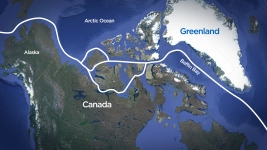
Submarines are just one element of the entire force, we cannot afford (financially or politically) nuclear submarines which allow us to better deal with the threats you describe but having conventional submarines interlinked with MPA's and frigates is a big boost to capability. Distant war theatre deployments would be done from allied nations and bases abroad, it's a capability that I am sure our allies in Europe and Asia will appreciate if we can field submarines of a suitable size and in enough number. HMCS Chicoutimi being deployed overseas to spy on the North Koreans comes to mind as of the last few years.
I would also be surprised if the Spanish were chosen as well.
But if you want MOTS you need a sub that is in production now. Likely with a proven design. And Spain, Japan and Korea are the ones that currently doing that. I like the Korean designs quite a bit. But that's really a surface look, I have no idea about what the guts look like. Just find them interesting.
I typed then read... 'pologies.Could be a CSC situation, program is changed to accept unproven to go for the most capable design. Carrot and stick.

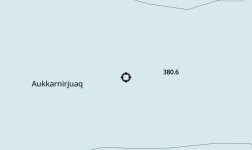
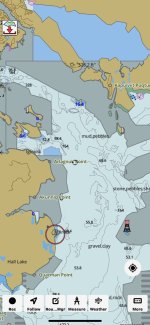
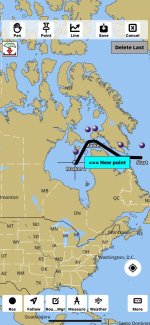
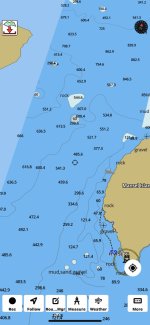
View attachment 78524
While some of that Fury and Hecla Channel passage gets tight in areas (4NM across) , there is pretty much 400’ of water in the channels, other than one point where it’s only on the 380 range
View attachment 78522
The sketchiest area appears to be cutting south to Hudson Bay I went into the app to plot a route - but the charts are pretty poor for that area. It appears to get shallower (~90ft) - while the SE access is significantly deeper.
View attachment 78523
If you take the Hudson Straight you are in 1,200’ of water. Up until you round Mansel Island then you are in 600ft until about the mid point of the bay.
View attachment 78525
I had to zoom out of the chart to show Mansel Island - and the deeper channels don’t show there - but they exist.
View attachment 78526
Mind you if I was red celling something taking the Fury and Hecla channel keeps one fairly remote - and you could drop some smaller packages to move into the shallow areas to sit and wait for guidance.
TBH, while I’m not a professional mariner (nor any sort of submariner) the (commercially available) charts in some parts of the passages are absolutely deplorable. Not the sort of thing one would want to put a lot of stock in for depth under keel in some areas.
If only we had an oceanographic survey ship...The worst part of the problem with charts and it speaks volumes. Is that for the best charts of our Arctic waters you have two choices the American Petroleum Institute and the Russians.
The Shortfin Barracuda is a black sheep as well, its potentially the largest and longest ranged option available but as you say, unproven and not under construction currently. Could be a CSC situation, program is changed to accept unproven to go for the most capable design. Carrot and stick.
